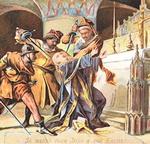Make your gift today!
Help keep Catholics around the world educated and informed.
Already donated? Log in to stop seeing these donation pop-ups.
Vatican Instruction demands equal dignity for traditional liturgy
May 13, 2011
In a new Instruction, the Vatican has made it clear that the use of the extraordinary form—the traditional Latin liturgy—should be available to all the faithful.
Universae Ecclesiae, released on May 13, follows up on the motu proprio Summorum Pontificum and clarifies the intent of Pope Benedict XVI. The Instruction says that the extraordinary should be given equal dignity in the Latin liturgy, and should be available whenever the faithful request it.
Universae Ecclesiae repeats that the traditional liturgy was never abolished, and no special permission is needed for priests to use the older rite. Bishops should not place any restrictions on the traditional liturgy, the Instruction says. On the contrary, seminaries should train priests to use the extraordinary form. The Instruction adds that a priest should be presumed qualified to celebrate Mass in the traditional form if he can pronounce the Latin, understand its meaning, and has used the liturgy in the past—including, it seems, in the many workshops that have been scheduled to train priests in the older rite.
The Instruction also emphasizes that Summorum Pontificum was not merely a response to traditionalists who have broken with the universal Church, but a response to a legitimate demand from many of the faithful, an effort to promote reverence in the liturgy, and a means of ensuring continuity with the traditions of Catholicism.
In another indication of the Vatican’s intention to encourage traditional liturgy, a Mass in the extraordinary form will be celebrated at the main altar of St. Peter’s basilica on Sunday, May 15. The celebrant will be Cardinal Antonio Cañizares Llovera, the prefect of the Congregation for Divine Worship.
A Reuters story on the new Instruction is inaccurate in two respects: First, in saying that the pressure for the traditional liturgy came—exclusively, the report implies—from members of the Society of St. Pius X. Second, in saying that the Vatican is now putting “pressure” on bishops to allow the use of the extraordinary form, when in fact the motu proprio was a directive from the Holy Father requiring the bishops’ adherence.
For all current news, visit our News home page.
Further information:
- "Universae Ecclesiae" to favour reconciliation within the Church (Vatican Radio)
- New Instruction “Universae Ecclesiae” on the application of the motu proprio "Summorum Pontificum (VIS)
- Instruction “Universae Ecclesiae” – the text and my initial observations (Father Zuhlsdorf)
- Two Masses for a Single Church (L'Espresso)
- Vatican upholds and strengthens Summorum Pontificum (Daily Telegraph)
- Vatican issues instructions for old Mass, warns against questioning papal authority (AP)
- Vatican increases pressure to allow Latin mass (Reuters)
All comments are moderated. To lighten our editing burden, only current donors are allowed to Sound Off. If you are a current donor, log in to see the comment form; otherwise please support our work, and Sound Off!
-
Posted by: bkmajer3729 -
Jun. 11, 2011 1:01 PM ET USA
Please provide references for evidence supporting "...EF parishes...abound with vocations". The comment uses the term "abound" indicating comparison to something that must not abound. In comment context below this must be to NO parishes. Please also provide references for evidence supporting how & why the NO culture is directly responsible for "...dissent and atrophied Catholic...vocations and identities...". I am not opposed to the EF Mass. But let's be sure our opinions are well informed.
-
Posted by: Gil125 -
May. 14, 2011 5:54 PM ET USA
You are obviously right, marttywinston. Once again, the Vatican demonstrates its tin ear. It wouldn't be any great trick to avoid the problem. It was Benedict XVI who named the Mass of 1962 (or Tridentine Mass) "extraordinary." He could certainly use this new document to change its name. If anybody there had an ear for this kind of thing.
-
Posted by: koinonia -
May. 14, 2011 5:04 PM ET USA
One might search history in vain to find terms like "Ordinary form" and "Extraordinary form." Atypical stuff. The severity and formality of Pope Pius V in promulgating the Tridentine Mass is unambiguous. Immemorial rites have always enjoyed protection in Catholic tradition due to pastoral concerns for souls. A hallmark of the innovations is the extensive departure from precedent in going about these radical changes. Finally, the Holy Father is clarifying the rights of both priests and laity.
-
Posted by: Cincinnatus -
May. 14, 2011 9:10 AM ET USA
Something unpleasant and strange is happening to this site! And your story about the Instruction is an example of your troubling new approach. To wit: Your headlines are becoming sensationalistic ("demands equal dignity"???) and your stories are becoming poorly organized, inaccurate and misleading (just read the Instruction carefully and you'll see what I mean). Your referenced articles may get things wrong, but you should get things right, and not just parrot inaccuracy.
-
Posted by: New Sister -
May. 13, 2011 1:56 PM ET USA
Universae Ecclesiae states that both forms are "of the same lex orandi of the Church." I cannot see this. In 40 years, the NO culture has bred dissent and atrophied Catholic religious vocations and identities of entire Nations. The EF parishes, as recent & as rare as they are, abound with vocations. They teach orthodoxy and forge bold Catholic identity in the lives of parishioners. How can such diametrically opposed results be of the same “lex orandi”?
-
Posted by: marttywinston6762 -
May. 13, 2011 12:22 PM ET USA
Equal dignity is not reflected in the terms ordinary and extraordinary.







